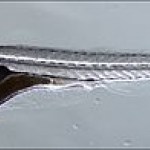calcium
I am very excited to report that the American Physiological Society in partnership with the The Physiological Society held a joint meeting from July 29-31 in Dublin, Ireland. The keynote lectures were given by Dr. Jerry Friedman from Rockefeller University and Dr. W Jon Lederer from the University of Maryland.
Dr. Friedman spoke about his research on obesity and how genetic factors might play a role. In fact, his team was responsible for discovering the obesity (ob) gene in mice in 1994 and identifying the similar gene in humans. The gene encodes the now iconic hormone leptin, which is…
Researchers from the University of York and the University of St. Andrews in the United Kingdom observed greater vasa parrots (Coracopsis vasa) using pebbles and date pits to extract a fine calcium powder from seashells that they would then lick off the shell. Their observations were published in Biology Letters. The birds were in essence creating their own nutritional supplements from materials readily available in their cages. While parrots are known to use their beaks to extract calcium from shells, this study shows the first known example of them using tools to accomplish the task.…
Image of a zebrafish larva from (NHGRI Press Photos).
Calcium is very important for the normal development, growth and survival of most vertebrates. Therefore, regulation of calcium intake and disposal is well-controlled. Mammals obtain most of their calcium from the diet, whereas fish obtain calcium by absorbing it from the external environment. For adults, this occurs in the gills and for larvae it is absorbed through the skin. What this means is that fish living in low calcium environments can acclimate by increasing the absorption of calcium from the water.
Dr. Kwong (Dept. of Biology…
New research published in Science Reports by Strauch et al., shows that fruit flies can tell the difference between cancerous and healthy cells. The researchers recorded calcium patterns indicative of neuronal activity that was stimulated in response to various odors emitted by healthy and cancerous cells. Because cells with cancer differ metabolically from healthy cells, they emit different volatile compounds that can be detected by olfactory receptor neurons on the antennae of fruit flies. When exposed to breast cancer cells or healthy cells, the flies exhibited different patterns in…
Image of a Giant African land snail from a Florida Department of Agriculture Division of Plant Industry handout.
Giant African land snails, like the one pictured above, are reportedly "one of the world's most destructive invasive species" as they not only consume over 500 plant species, they can actually eat stucco (apparently a good source of calcium). Therefore, I am sure you can imagine the damage they are causing in South Florida where they can grow as large as a rat. Since 2011 when the snail was first seen, more than 117,000 have been captured in Miami-Dade County.
More problemmatic…
I find it ironic - okay, I find it slightly hilarious - that the house plant which results in the most calls to poison control centers is called the Peace Lily.
Next on the list is Pokeweed - which people have a bad habit of mistaking for other edible wild plants - followed by two holiday favorites, poinsettias and holly plants.
As the Peace Lily is popular at Easter, one could conclude that holiday plants are particularly dangerous. But there's actually a more interesting - if less amusing - background to such risks.
Most of the calls, of course, aren't funny at all. They concern curious…

